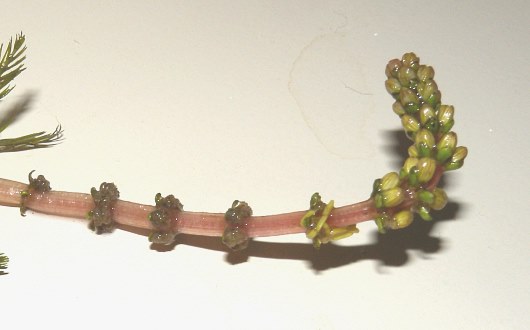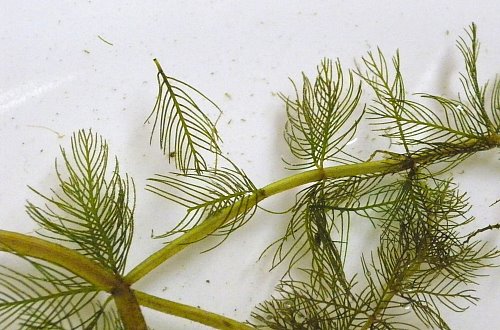
The upper stems terminate in floral spikes about 2-8" long. These spikes are usually exerted above the water surface. The central stalks of these spikes resemble the stems, except they are slightly more narrow. Each spike produces sessile unisexual flowers (rarely perfect) that are arranged in whorls of 4; the male flowers are located above, while the female flowers are located below. These whorled flowers are widely separated from each other along each spike. Each male flower is about 3 mm. long, consisting of 4 pink petals and 8 stamens; the petals are early-deciduous. Each female flower is about 2-3 mm. long, consisting of a 4-lobed pistil with feathery stigmata; petals are insignificant or absent. Underneath each male flower, there is a green bractlet that is oblong-lanceolate or oblanceolate in shape. Underneath each female flower, there is a green bractlet that is oval in shape. These bractlets are about the same length or a little shorter than the flowers. The blooming period usually occurs from early summer to early fall. If the weather and water are warm, individual plants may bloom more than one time per year. The flowers are cross-pollinated by wind.

Afterwards, the floral spikes start to sag into the water as the fruits of the female flowers develop. Each fruit is 2 mm. long and globoid-ovoid in shape with 4 lateral lobes; these lobes are smooth, except along their margins, where they may be slightly warty. Each fruit divides into 4 chunky 3-sided seeds. The root system is shallow and fibrous. This plant can reproduce vegetatively as its fragile stems often divide, forming plant fragments that drift in the water. If the stems of these plant fragments become lodged in the substrate of the water body, they can develop new roots. Winter turions (dense buds of cold-adapted leaves) are not developed; instead this plant dies down to its root crown for the winter.
Cultivation: The preference is full sun, clear alkaline water up to 8' deep, and a substrate containing clay or other fine inorganic material. However, Eurasia Water Milfoil will adapt to more acidic water and substrates containing sand, silt, or gravel. This plant can spread aggressively and it should not be planted in North America.
Faunal Associations: One possible biocontrol agent is the Water Milfoil Weevil (Euhrychiopsis lecontei). This weevil is native to the American Midwest and it is known to feed on Eurasian Water Milfoil. However, it will also feed on native water milfoil species (Myriophyllum spp.). Pond Snails (Lymnaea spp.) and Wheel Snails (Planorbis spp.) also feed on these plants. Some vertebrate animals feed on water milfoil species. According to Pearse (1918), 2-5% of the food of three fishes consisted of water milfoil in Wisconsin; these fish species are Lepomis gibbosus (Pumpkinseed), Noturus gyrinus (Tadpole Cat), and Perca flavescens (Yellow Perch). Several turtles also feed on these aquatic plants, including Chelydra serpentina (Snapping Turtle), Chrysemys picta (Painted Turtle), Emys blandingii (Blanding's Turtle), and Trachemys scripta (Slider); see Lagler (1943) and Ernst et al. (1994). Several wetland birds eat the foliage and/or seeds of water milfoil. They include such species as Cygnus buccinator (Trumpter Swan), Anas discors (Blue-Winged Teal), Anas platyrhynchos (Mallard), Aythya affinis (Lesser Scaup), Aythya valisineria (Canvasback), Oxynura jamaicensis (Ruddy Duck), Limnodromus griseus (Short-Billed Dowitcher), Calidris melanotos (Pectoral Sandpiper), and Calidris himantopus (Stilt Sandpiper); see Martin et al. (1951/1961) and Havera (1999). The foliage is a minor source of food for muskrats (Hamerstrom & Blake, 1939). Eurasian Water Milfoil can be spread through human-related activities. This aquatic plant can cling to boat hulls, propellers, anchors, boat trailers, and fish nets, from which it can escape into previously unoccupied lakes and rivers. Because this plant is sometimes cultivated in aquariums, it can spread into waterways when the contents of aquariums are dumped by their owners.

Photographic Location: The plant fragments were collected from a pond near Champaign, Illinois, but they were photographed indoors.
Comments: This is one of the most invasive aquatic plants in the American Midwest. It closely resembles a native species, Myriophyllum sibiricum (Northern Water Milfoil), but this latter species has fewer filiform lobes along the sides of its leaves (about 5-9 lobes for each side). When Northern Water Milfoil is taken out of the water, its leaves are less prone to collapse than those of Eurasian Water Milfoil. Both of these species can be distinguished from other water milfoil species (Myriophyllum spp.) by the small size of their floral bracts, which are usually no longer than their flowers (3 mm. in length or less).